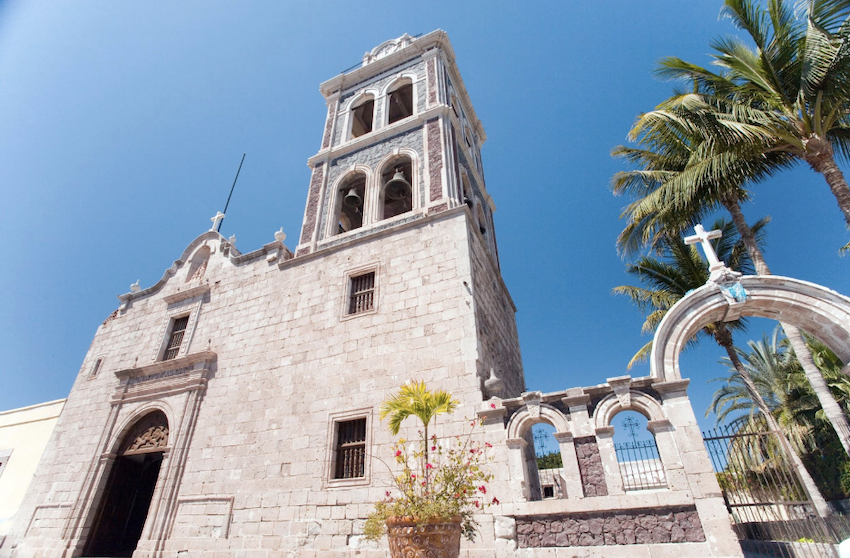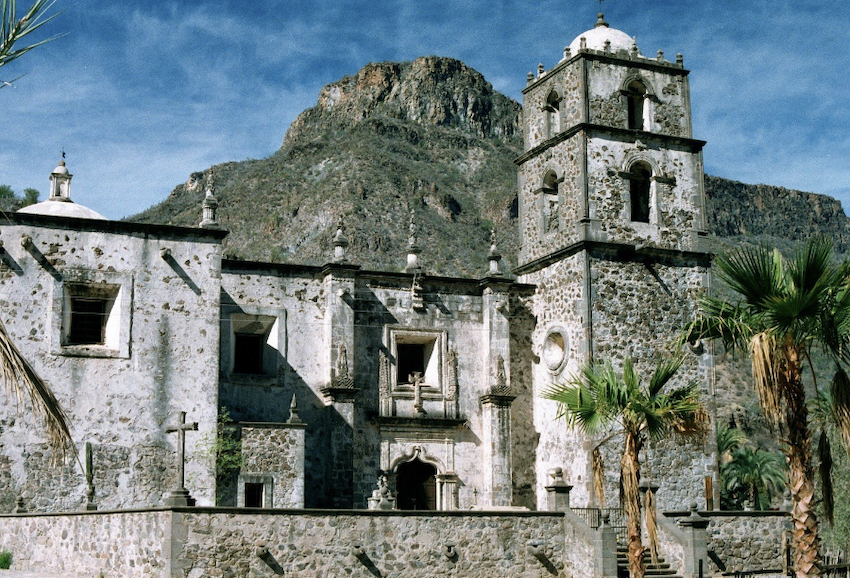No era in the history of Baja California has been as oft-written about as the Spanish mission era, and with good reason, as the successive waves of Jesuit, Franciscan, and Dominican missionaries during the 17th, 18th, and 19th centuries brought sweeping political and cultural changes to the peninsula and left a lasting legacy.
Of course, the most tangible legacy is found in the missions that were built. Several of these remarkable archaeological monuments still exist and are “well worth the dusty drive” it takes to visit them, as David Kier, an expert on the topic, aptly puts it. David’s book, Baja California Land of Missions, was published in 2016 and remains a definitive print resource.

The ultimate resource, however, is David himself, since he continues to visit these sites regularly, travels touched upon in this interview and covered in greater detail in articles on his website: Viva Baja.
What was the timeline for Jesuit, Franciscan, and Dominican mission building on the Baja California peninsula?
The Jesuits began the California mission program in 1697, at Loreto. The Franciscans replaced the Jesuits in 1768. This period lasted five years, and the Franciscans founded only one mission on the peninsula, San Fernando. Their primary focus was on the 1769 expedition to Alta California led by Gaspar de Portolá and Junípero Serra, which was foundational in settling what is now the U.S. state of California.
The missions on the Baja California peninsula and the land between the San Fernando and San Diego missions were handed over to the Dominican order in 1773. The Franciscans wanted only to work in Alta California. So the Dominicans had that northern land in Baja to establish their own missions on.
How many missions were built during these respective eras, and how many still exist? I know, for example, that all the ones south of La Paz are gone.
The Jesuits founded 17 missions, eight of which were relocated one or more times to better locations, often adopting a different name after the move. This has proved confusing for modern writers regarding the actual number of true missions. A mission is a project, like a business or corporation, and not a specific location or a church building alone.

The Franciscans founded just one mission and handed it over to the Dominicans four years later. The Franciscans built the adobe churches at San Borja and Santa María. The adobe ruins of San Fernando are from the Dominican period.
The Dominicans were on the peninsula the longest, established nine missions (five of which were moved at least once), and continued to operate the Jesuit and Franciscan missions that were open when they arrived in 1773 until each was abandoned. The Dominicans built the stone churches we see today at the Jesuit-founded missions of San Ignacio, Santa Gertrudis, and San Borja. The last two Dominican missions were founded after Mexican independence, so they are not considered true Spanish missions. The padre who built them, Felix Caballero, had no authorization.
Original 1700s stonewall mission churches (some with repairs and new roofs) are found at Loreto, San Javier, Mulegé, Comondú, San Ignacio, San Luis Gonzaga, Santa Gertrudis, and San Borja. That’s eight in total.
What were the most interesting historical events associated with the Baja missions? Are there any myths or legends associated with them?
Oh my, there are so many! The Pericú Revolt began on October 1, 1734, in Santiago, which led to the destruction of the four southernmost missions: at Santiago, San José del Cabo, Todos Santos, and La Paz.
The “Chilean Invasion” of 1822, led by English Admiral Thomas Cochrane, who ordered attacks on three missions — at San José del Cabo, Todos Santos, and Loreto. These attacks occurred because Spain had lost the Mexican War for Independence, but isolated Baja California still had government offices flying Spanish flags. Cochrane had served as Chile’s admiral since 1818, when he helped Chile defeat Spain to gain its independence.

The lost mission legends are popular, and searching for them can be a fun activity! There were never any real lost missions. However, a map created by the Jesuits in 1757 showed three missions beyond San Ignacio as “under construction,” feeding the rumors.
San Juan Bautista, west of San Ignacio, near Punta Abreojos in the Sierra Santa Clara, is one of them. Known as the Lost Santa Clara Mission, nothing has been found there, at least that we know of. Dolores del Norte is another. Even the old Auto Club maps showed it, putting it north of San Ignacio. In reality, the name of this mission was changed to Santa Gertrudis upon its founding to honor the wife of the financial benefactor (Note: Gertrudis was the name of the wife of José de la Puente, aka the Marqués de Villapuente, who funded many of Baja’s missions).
Yet, Dolores del Norte still comes up along with Santa Gertrudis on some maps. The impressive visita ruins (a visita was a small sub-mission outpost) in San Pablo Canyon are also sometimes referred to as a mission by INAH (the Instituto Nacional de Antropología e Historia).
Santa María Magdalena, the third mission on the 1757 map shown between San Ignacio and Bahía de los Angeles, has more going for it. Bells with that name are at Mission Santa Gertrudis, as if the mission was aborted and the bells were given to the nearest mission. Historical author (and Desert Magazine editor) Choral Pepper believes the mystery walls at Bahía Las Animas might just be the aborted mission project.
Finally, the Lost Mission of Santa Isabel. This is a more recent legend from the late 1800s to early 1900s as an explanation for what came of Jesuit treasures when they learned of their impending banishment. A waterhole on the 1757 map named Santa Isabel, north of the final Jesuit mission of Santa María and Gonzaga Bay, may be the source of the name. So many wild stories about Santa Isabel searches have been published, including my own.
What, in your opinion, are the best missions to visit, and why?

I enjoy visiting all the mission locations that I can. The highly impressive San Javier (Misión San Francisco Javier de Viggé-Biaundó), known as the “jewel of the missions,” and the magnificent San Ignacio are top contenders. Both are on paved roads for easy access. San Borja is just over twenty miles from a highway and stands out as a must-see. It is the furthest-north stone mission on the peninsula. Coming upon it in the middle of the harsh desert is quite the experience.
My favorite mission location is Santa María. Its ruins are the most intact of the adobe missions. Located in a most difficult location, only the best-equipped four-wheel-drive vehicles can hope to reach it. It takes three hours or more just to travel the fifteen miles of dirt road from Cataviña or Santa Ynez. Don’t go without another vehicle to support you. My fifth visit to it was three years ago.
What should our readers know about going to see these missions before planning a trip?
They should study the many missions either in my book or on my website pages to pick out the ones that look the most interesting or have an intriguing story. Each mission has an interesting history. Two months ago, a friend and I went to eight mission sites that are along or very close to Federal Highway 1, between Tijuana and Cataviña, over a weekend.
We also visited other interesting sites proving Baja is a land of so many wonders that a lifetime of travels there cannot spoil opportunities to see more. Your readers will need to decide how they travel and what they want to see. For some, that may mean flying in, renting a car, and staying at hotels. Others will do as I always have done, secure a capable vehicle, and camp under a sky so full of stars that you will think you are on the dark side of the moon!
Do you have any tips on border crossing or driving in Baja? Is there an established route for an itinerary to visit multiple missions?
Yes, I try to keep a page updated with details on driving across the border. Keep in mind, things can and do change, so be aware of that and try to enjoy the experience of driving into another country.
The itinerary can be as large as desired. The only missions that have no direct road or easy automobile access are San Pedro Mártir, Los Dolores Apaté, and Santa María. The Guadalupe mission site, forty miles west of Mulegé, may be fenced off to visitors, according to a recent report. There are only some walls, foundations, and stairs to see.
Most of the missions are on or near paved roads. Three of the intact, stone missions — Santa Gertrudis, San Luis Gonzaga, and San Borja — are some distance away from the highway but well worth the dusty drive if you are in a truck or SUV.
Chris Sands is the Cabo San Lucas local expert for the USA Today travel website 10 Best, writer of Fodor’s Los Cabos travel guidebook and a contributor to numerous websites and publications, including Tasting Table, Marriott Bonvoy Traveler, Forbes Travel Guide, Porthole Cruise, Cabo Living and Mexico News Daily. His specialty is travel-related content and lifestyle features focused on food, wine and golf.




